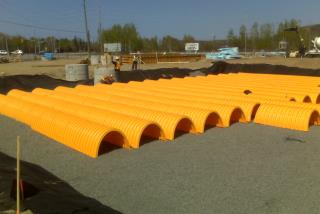Soakaways, Infiltration Trenches and Chambers
 Soakaways, infiltration trenches and chambers are all LID technologies, similar in that they consist of sub-surface reservoirs that store and infiltrate stormwater runoff at the lot level. These technologies provide an opportunity for infiltrating runoff from roofs, walkways, parking lots, and low to medium traffic roads without consuming a substantial amount of land area. They are particularly useful on sites where space is limited and directing runoff to vegetated areas on the lot is not feasible or preferred.
Soakaways, infiltration trenches and chambers are all LID technologies, similar in that they consist of sub-surface reservoirs that store and infiltrate stormwater runoff at the lot level. These technologies provide an opportunity for infiltrating runoff from roofs, walkways, parking lots, and low to medium traffic roads without consuming a substantial amount of land area. They are particularly useful on sites where space is limited and directing runoff to vegetated areas on the lot is not feasible or preferred.
While these three technologies function similarly, there are significant differences in their design elements. Soakaways typically consist of rectangular or circular stone-filled, geotextile-lined excavations that receive roof and walkway runoff via a perforated pipe inlet. The soakaway stores the water and allows it to infiltrate into the native soil.
An infiltration trench is a design variation in which the excavation is in the form of a long rectangular trench, often situated along the rear lot line away from the building foundation. This design is usually more efficient and cost effective where buildings are close together and the only space available for infiltration is a narrow strip of land between buildings or within the infrastructure rights of way. For both soakaways and trenches that treat roof runoff, pre-treatment requirements are minimal and only require the installation and regular cleaning of roof leader screens that trap leaves and other debris.
Infiltration chambers differ from both of these technologies in that they provide a large volume of underground void space while still offering the structural stability required for a sub-surface BMP. They include a range of proprietary manufactured modular structures that are may be installed under paved parking lots or landscaped areas. Most of these types of structures have open bottoms, perforated side walls, and optional underlying stone-filled reservoirs. In addition to infiltrating roof and walkway runoff, parking lot and road runoff can also be treated provided that sedimentation pre-treatment practices are in place. Because of the substantial storage volume provided by this technology, it is commonly applied on sites with little or no space available for other stormwater BMPs.
CSA Standard B184, Polymeric Subsurface Stormwater Management Structures is now available for use. CSA B184 is the only consensus standard for subsurface stormwater management chambers in Canada. The CSA standard covers subsurface stormwater management structures used in the collection, detention, retention, and infiltration of stormwater runoff. It specifies requirements for design, materials, manufacture, and structural integrity, as well as for proper installation and maintenance. It also addresses issues such as constructability and toxicity. CSA B184 will help suppliers demonstrate that their chambers are suitable for their intended purpose and allow regulatory authorities to approve them for use in their jurisdictions. It can also be used for certification and for referencing in regulatory documents.
Photo credit: StormTech
